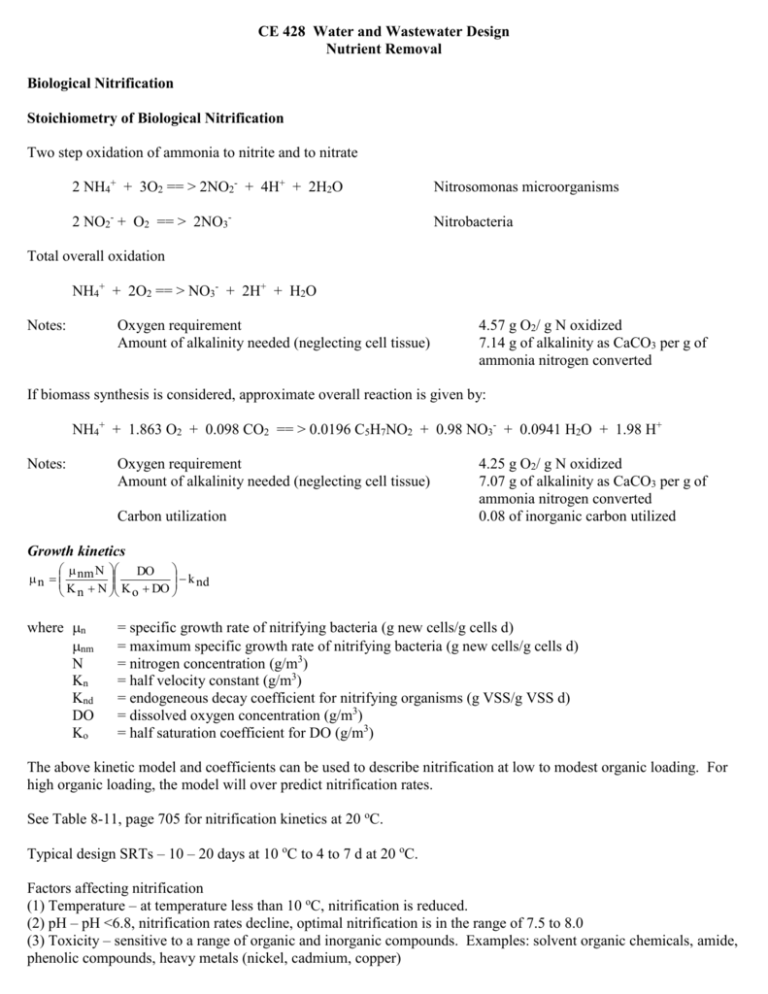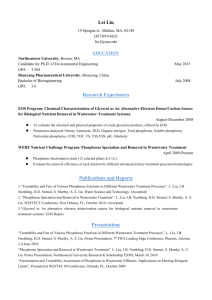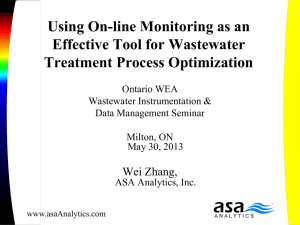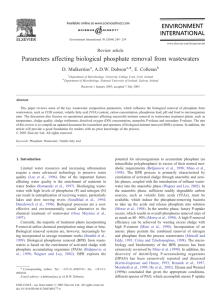Biological Nitrifica..
advertisement

CE 428 Water and Wastewater Design Nutrient Removal Biological Nitrification Stoichiometry of Biological Nitrification Two step oxidation of ammonia to nitrite and to nitrate 2 NH4+ + 3O2 == > 2NO2- + 4H+ + 2H2O Nitrosomonas microorganisms 2 NO2- + O2 == > 2NO3- Nitrobacteria Total overall oxidation NH4+ + 2O2 == > NO3- + 2H+ + H2O Notes: Oxygen requirement Amount of alkalinity needed (neglecting cell tissue) 4.57 g O2/ g N oxidized 7.14 g of alkalinity as CaCO3 per g of ammonia nitrogen converted If biomass synthesis is considered, approximate overall reaction is given by: NH4+ + 1.863 O2 + 0.098 CO2 == > 0.0196 C5H7NO2 + 0.98 NO3- + 0.0941 H2O + 1.98 H+ Notes: Oxygen requirement Amount of alkalinity needed (neglecting cell tissue) Carbon utilization 4.25 g O2/ g N oxidized 7.07 g of alkalinity as CaCO3 per g of ammonia nitrogen converted 0.08 of inorganic carbon utilized Growth kinetics N DO k nd n nm K n N K o DO where n nm N Kn Knd DO Ko = specific growth rate of nitrifying bacteria (g new cells/g cells d) = maximum specific growth rate of nitrifying bacteria (g new cells/g cells d) = nitrogen concentration (g/m3) = half velocity constant (g/m3) = endogeneous decay coefficient for nitrifying organisms (g VSS/g VSS d) = dissolved oxygen concentration (g/m3) = half saturation coefficient for DO (g/m3) The above kinetic model and coefficients can be used to describe nitrification at low to modest organic loading. For high organic loading, the model will over predict nitrification rates. See Table 8-11, page 705 for nitrification kinetics at 20 oC. Typical design SRTs – 10 – 20 days at 10 oC to 4 to 7 d at 20 oC. Factors affecting nitrification (1) Temperature – at temperature less than 10 oC, nitrification is reduced. (2) pH – pH <6.8, nitrification rates decline, optimal nitrification is in the range of 7.5 to 8.0 (3) Toxicity – sensitive to a range of organic and inorganic compounds. Examples: solvent organic chemicals, amide, phenolic compounds, heavy metals (nickel, cadmium, copper) (4) Un-ionized ammonia – nitrification is inhibited by un-ionized ammonia or free ammonia. Example, at 20 oC, 100 mg/L of NH3-N may inhibit NH4+ - N oxidation. Biological Denitrification - reduction of nitrate to nitric oxide, nitrous oxide and nitrogen gas. - bacteria involved are typically heterotrophic and autotrophic Stoichiometry of Biological Denitrification - needs an organic substrate with nitrate as the electron acceptor Wastewater C10H19O5N + 10 NO3- == > 5 N2 + 10 CO2 + 3 H2O + NH3 + 10 OHExternal substrate such as methanol 5CH3OH + 6 NO3- == > 3 N2 + 5 CO2 + 7 H2O + 6 OHAcetate 5CH3COOH + 8NO3- == > 4 N2 + 10 CO2 + 6 H2O + 8 OHNotes: Amount of alkalinity needed (neglecting cell tissue) Denitrification inhibited 3.57 g of alkalinity as CaCO3 per g of nitrate nitrogen reduced 02 > 0.2 mg/L Kinetics See Table 8-18, page 756 for kinetics data Substrate utilization is given by the following equation: K ' o kXS NO 3 rsu K ' K S NO 3 K o DO s s, NO3 where K'o = Do inhibition coefficient for nitrate reduction (mg/L) (0.1 - 0.2 mg/L) Ks, NO3 = half velocity coefficient for nitrate limited reaction (mg/L) (0.1 mg/L) = fraction of denitrifying bacteria in the biomass (g VSS/g VSS) Biological Phosphorus Uptake - Biological phosphorus uptake or removal (BPR) is based on the theory of luxury uptake of phosphorus. Exposing mixed liquor to an anaerobic/aerobic sequence in the biological reactor selects microorganisms that accumulate higher levels of intracellular phosphorus than other microorganisms. - Phosphorus-removing microorganisms are able to rapidly assimilate and store volatile fatty acids (VFAs) such as acetate and other fermentation products under anaerobic conditions. Phosphorus (as orthphosphate - PO43-) is released in the anaerobic zone to produce the energy needed to take up the fermentation products, which are stored as poly-ß-hydroxybutyrate (PHB). - Phosphorus-removing microorganisms produce energy by oxidizing the stored fermentation products in the aerobic zone while simultaneously accumulating intracellular phosphate (polyphosphates). The ability of phosphorusremoving microorganisms to rapidly assimilate the fermentation products under anaerobic conditions gives them a competitive advantage over other microorganisms and results in their preferential growth in the wastewater treatment system. Thus, the anaerobic-aerobic sequence allows the selection of a large population of phosphorus-removing microorganisms. - In BPR systems, phosphorus accumulates in the biomass and is removed in the form of waste activated sludge. A recent study showed that nearly all the enhanced phosphorus removal is due to the storage of polyphosphates. This results in an increase in the inorganic sludge mass but no significant increase in organic sludge production when compared to a conventional activated sludge process without chemical addition. Chemical precipitation of phosphorus has been estimated to increase sludge production by an average of 26%. - several strains of Acinetobacter, Arthrobacter, globiformis and Pseudomonas spp. have been reported to be polyphosphate accumulating bacteria responsible for biological phosphorus removal - other organisms such as Pseudomonas, Moraxella and Klebsella also has been reported as capable of removing phosphorus from wastewater bbb - Several process configurations (some patented, others not) are currently being applied worldwide for biological phosphorus removal. Some process configurations incorporate nitrogen removal by nitrification and denitrification along with biological phosphorus removal. However, all are based on the sequential exposure of microorganisms to anaerobic and aerobic conditions - Many states have phosphorus limits - such as removal of 90% of the phosphorus or a 1 mg-P/L effluent limit depending on the receving body of water. But to encourage BPR, the standards could be either the 1 mg-P/L effluent standard if chemical phosphorus removal is used or the alternative effluent limit of 1.5 mg-P/L if the BPR process is used. - The overall total phosphorus removal obtained in a conventional biological wastewater treatment is generally less than 20% and is even less in wastewater treatment plants where anaerobic digester supernatant is recycled to the head of the plant. Notes: 10 g of bsCOD will be required to remove 1 g of phosphorus by biological storage mechanism.







